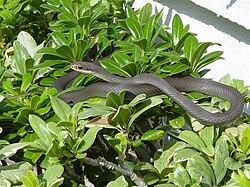Southern black racer
| Coluber constrictor priapus | |
|---|---|

| |
| southern black racer | |
| Scientific classification | |
| Kingdom: | |
| Phylum: | |
| Subphylum: | |
| Class: | |
| Order: | |
| Suborder: | |
| Family: | |
| Genus: | |
| Species: | |
| Subspecies: | C. c. priapus
|
| Trinomial name | |
| Coluber constrictor priapus Dunn & Wood, 1939
| |
Coluber constrictor priapus, commonly known as the southern black racer, is one of the more common subspecies of nonvenomous Coluber constrictor snakes in the Southeastern United States. The name priapus refers to the proximal spines of the hemipenes being much enlarged into basal hooks, which is characteristic of this subspecies.[1] These snakes are quite active during the day, which increases the chance of sightings. They will eat almost any animal they can overpower, including, rodents, frogs, toads, and lizards. They have been known to charge at people in an attempt to frighten them [citation needed], but will usually retreat if challenged. They are not venomous. Members of this species generally do not tolerate handling – even after months in captivity – and will typically strike and flail wildly every time they are handled. These snakes are usually thin with a jet black dorsal side with a grey belly and white chin. They are quite fast, giving rise to the name "racer".
Habitat and habits
Coluber constrictor priapus Average size: 20-56 inches; Record 72 inches. Range: Throughout most of Florida. Diet: Lizards, snakes, frogs, insects, rodents and small birds. Status: Common Note that the Southern Black Racer has a white chin. An Indigo Snake normally has a dark to reddish orange chin. [2]
Diet
The Southern Black Racer is a predator that relies on lizards, insects, moles, birds, eggs, small snakes, rodents, and frogs. Despite its specific name constrictor (scientific name: Coluber constrictor), the Racer is more likely to suffocate or crush its victim into the ground rather than coiling around it in typical constrictor fashion.[3]
Man remains the biggest enemy of Black Racers. Many are killed on highways and others are intentionally killed out of fear. The white chin causes many people to kill this snake, believing that it is a Cottonmouth—a venomous snake more commonly called a Water Moccasin. The venomous snake has a white lining inside of its mouth. Racers are nonvenomous and do not breed with Cottonmouths. Natural enemies include such birds of prey as hawks including the Red-shouldered Hawk and Broad-winged Hawk. These perching and soaring birds have keen eyesight and drop down from above to capture Black Racers and other snakes thus making their speed and ground awareness ineffectual.[4]
It is believed[by whom?] snakes are color blind. Adult Racers are solid black, but juveniles are blotched gray and reddish brown. Adult racers are 24–55 inches (0.6 - 1.4 m) long and rarely exceed 70 inches (1.8 m). Breeding and egg laying occur between March and August. Up to 23 eggs are laid, but as in most reptiles, no interest is taken in hatching or rearing the young. Newly hatched Racers are about 6 inches (15 cm) long and rely on their juvenile camouflage for survival. Like other snakes, the Racer will shed its skin several times a year.[5]
Gallery
-
Black Racers wait for prey in dry leaves and brush.
-
Black Racers are excellent climbers.
-
Black Racers are not strangers to suburban yards.
-
Black Racer with head elevated
-
Black Racer
-
Like most cold blooded creatures, the Black Racer relies on sun and shade to regulate its temperature.
-
Note the white marking around the mouth.
-
A color blind Racer examines a green hose.
-
A 24" shed Racer skin.
-
Stalking a Dragonfly.
-
Resting and waiting for food from a tree.
-
Southern Black Racer at St. Sebastian River Preserve State Park in Indian River County, Florida, U.S.A.
References
- ^ Schmidt,K.P. and D.D. Davis. 1941. Field Book of Snakes of the United States and Canada. G.P. Putnam's Sons. New York. 365 pp. (Coluber constrictor priapus, p. 125.)
- ^ E. Laurence Palmer, ed. (1949, 1974). Fieldbook of Natural History. McGraw Hill. ISBN 0-07-048425-2.
{{cite book}}: Check date values in:|year=(help); Unknown parameter|month=ignored (help)CS1 maint: year (link) - ^ E. Laurence Palmer, ed. (1949, 1974). Fieldbook of Natural History. McGraw Hill. ISBN 0-07-048425-2.
{{cite book}}: Check date values in:|year=(help); Unknown parameter|month=ignored (help)CS1 maint: year (link) - ^ The Audubon Society Field Guide To North American Birds. Alfred A. Knopf. 1977. ISBN 0-394-41405-5.
{{cite book}}: Unknown parameter|editors=ignored (|editor=suggested) (help); Unknown parameter|month=ignored (help) - ^ Roger Tory Peterson, ed. (1979). National Audubon Society Field Guide to North American Reptiles and Amphibians. Alfred A Knopf. ISBN 0-394-50824-6.
{{cite book}}: Unknown parameter|month=ignored (help)












